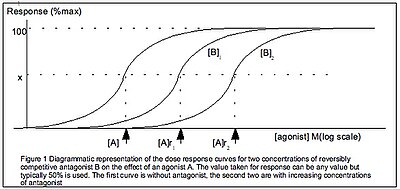
Back EC50 German Concentration efficace médiane French EC50 Italian EC50 Japanese EC50 Portuguese EC50 Russian EC50 Serbo-Croatian EC50 Serbian EC50 Turkish EC50 Ukrainian

Half maximal effective concentration (EC50) is a measure of the concentration of a drug, antibody or toxicant which induces a biological response halfway between the baseline and maximum after a specified exposure time.[1] More simply, EC50 can be defined as the concentration required to obtain a 50% [...] effect[2] and may be also written as [A]50.[3] It is commonly used as a measure of a drug's potency, although the use of EC50 is preferred over that of 'potency', which has been criticised for its vagueness.[3] EC50 is a measure of concentration, expressed in molar units (M), where 1 M is equivalent to 1 mol/L.
The EC50 of a graded dose response curve therefore represents the concentration of a compound where 50% of its maximal effect is observed.[4] The EC50 of a quantal dose response curve represents the concentration of a compound where 50% of the population exhibit a response,[5] after a specified exposure duration.
For clarification, a graded dose response curve shows the graded effect of the drug (y axis) over the dose of the drug (x axis) in one or an average of subjects. A quantal dose response curve shows the percentage of subjects where a response is noted in an all-or-none manner (y axis) over the dose of the drug (x axis).
For competition binding assays and functional antagonist assays IC50 is the most common summary measure of the dose-response curve. For agonist/stimulator assays the most common summary measure is the EC50.[6]
The EC50 is also related to IC50 which is a measure of a compound's inhibition (50% inhibition).
- ^ "Introducing dose response curves". Graphpad Software. Archived from the original on 2012-07-30.
- ^ Chen, Zheng; Bertin, Riccardo; Froldi, Guglielmina (2013-05-01). "EC50 estimation of antioxidant activity in DPPH assay using several statistical programs". Food Chemistry. 138 (1): 414–420. doi:10.1016/j.foodchem.2012.11.001. ISSN 0308-8146. PMID 23265506.
- ^ a b Neubig, Richard R. (2003). "International Union of Pharmacology Committee on Receptor Nomenclature and Drug Classification. XXXVIII. Update on Terms and Symbols in Quantitative Pharmacology" (PDF). Pharmacological Reviews. 55 (4): 597–606. doi:10.1124/pr.55.4.4. PMID 14657418. S2CID 1729572.
- ^ "Northwestern Molbiosci EC50 definition". Archived from the original on 2010-06-14. Retrieved 2019-05-27.
- ^ "Drug Dose and Clinical Response". Archived from the original on 2007-02-20. Retrieved 2019-04-16.
- ^ Cite error: The named reference
Assaywas invoked but never defined (see the help page).
© MMXXIII Rich X Search. We shall prevail. All rights reserved. Rich X Search